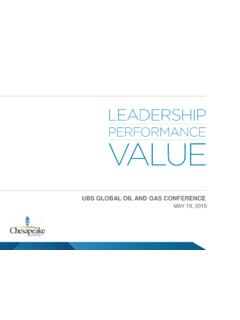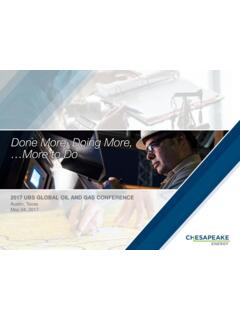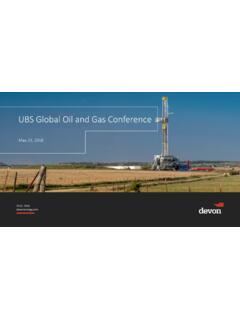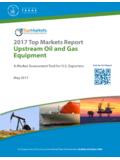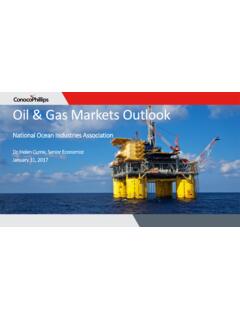Transcription of Global oil & gas tax newsletter Views from around the world
1 Global oil & gas tax newsletter Views from around the worldAugus t 2018 In this issueEditor s introduction 2 New trade friction: Impact on the oil and gas industry 3 Algeria: Overview of the current fiscal environment 5 China: Income tax incentives for crude oil futures trading 8 Gulf Cooperation Council: Practical impact of VAT in the oil and gas sector 9 India: Recent tax developments in the oil and gas sector 12 Nigeria: Update on the proposed tax reform of the petroleum industry 17 Uganda: Fiscal framework for the East Africa crude oil pipeline 22 Global oil & gas tax newsletter | Views from around the world 2 Welcome to the second edition of the Global oil & gas tax newsletter for and gas prices are enjoying a sustained recovery, and in this edition, we look at three countries that are planning to take advantage of this resurgence by updating their tax rules for upstream oil and gas activities to encourage further investment.
2 Nigeria has been on the road to fiscal reform for almost 16 years and the current regime, with its complexities and uncertainties, is acknowledged by all parties to require fundamental changes. Unsurprisingly, it has been easier to agree that changes are needed than to agree on what those changes should be, and even within the last 12 months there has been another significant shift in the proposed approach to tax reform for the sector. Given Nigeria s economic potential, and the role that domestically produced hydrocarbons can play in realizing this potential, further delays and uncertainty hopefully will be minimized. India and Algeria are two other countries with significant upstream sectors that are starting to address the need for reform to promote investment. However, these countries are at a much earlier stage in the other articles, we look at the progress of the value added tax (VAT) implementation in the Gulf States, and we consider the changes introduced in China to promote its shale industry and commodity futures exchange.
3 We then examine the fiscal regime for Uganda s oil export pipeline and some of the immediate consequences for the industry as a result of the United States trade policies. No doubt, this last item will have significant additional ramifications as its full impact becomes clear and we will certainly return to it in later editions. This will be my last edition as I leave Deloitte at the end of August after 16 years with Deloitte member firms in the former Soviet Union, East Africa and, most recently, the UK. I d like to express my thanks to all our contributors for their efforts, Joanna Lambeas for her support in the review and publication process and Chris Roberge, Deloitte s Global Tax & Legal Leader for the Energy, Resources & Industrials industry, for supporting this initiative. Bill Page Editor s introductionBill Page, Deloitte UKGlobal oil & gas tax newsletter | Views from around the world 3 New trade friction: Impact on the oil and gas industrySarah Chin and Robert Olson, Deloitte Hong KongThe beginning of 2018 brought a flurry of trade actions and reactions for the US and its trading partners.
4 Several measures have been imposed by various countries, while additional measures have been announced and may be imposed in the future. For the oil and gas industry, perhaps one of the most concerning measures is already in effect. Specifically, the original steel and aluminum safeguards and related retaliation by China directly impacts imports of certain steel products vital to the oil and gas industry. This article examines some of the key actions already taken that likely directly affect industry-related actions have been adopted under the terms of existing world Trade Organization (WTO) agreements. However, not all parties agree that the actions conform to the agreements. For example, the US safeguard duties on steel and aluminum have been disputed at the WTO by China, India, Canada, Mexico, Norway and the European Union (EU). Meanwhile, during the same period, the US has initiated a dispute with China concerning the protection of intellectual property rights, in addition to implementing safeguard tariffs against a wide variety of Chinese first action to gain widespread media attention was the steel and aluminum safeguard tariffs announced by US President Trump on 23 March 2018.
5 Under these measures, aluminum products are subject to a safeguard duty of 15 percent. For steel products, a 25 percent duty applies to a range of steel primary shapes and steel articles, including several products essential to oil and gas exploration, production and distribution. Specifically, the tariffs apply to a class of goods referred to as oil country tubular goods (OCTG), which include the following steel products: Line pipe used for oil or gas pipelines; and Casing, tubing and drill pipe used in drilling for oil or of the safeguard order, these products generally are duty free upon importation into the US. However, for some countries and suppliers, anti-dumping duties already apply. For example, Chinese suppliers are subject to anti-dumping duties on imports into the US of OCTG under many of the same tariff codes as the safeguard tariffs. The new US steel safeguard duties apply to all countries except Argentina, Australia, Brazil and South Korea.
6 These countries have reached agreements with the US to implement measures to: constrain steel imports; reduce excess steel production and excess steel capacity; contribute to increased capacity utilization in the US; and prevent the transshipment of steel articles and avoid import a result of the additional tariffs on steel and aluminum, on 1 April 2018, China retaliated in-kind by introducing a 15 percent tariff on the same categories of US goods for import into China, plus other US goods, such as wine and agricultural products. China-based oil and gas companies, therefore, are seeing a cost increase on OCTG, although in their case it is on a smaller scale, given the volume of steel products they import from the US. Global oil & gas tax newsletter | Views from around the world 4 This was not the first trade action to take place in 2018. Before the announcement of the steel and aluminum safeguards in February, the US had announced other safeguard duties covering washing machines and solar cells.
7 Solar cells are a significant and growing export product for China. Following these initial actions, a steady stream of trade measures has been announced and/or initiated by China, Mexico, Canada and the EU. In some cases, there has been mention of potentially introducing additional tariffs, yet in other cases, the legal actions necessary to implement additional tariffs have been initiated, making these actions more likely to take effect. This raises the question of whether these trade measures are the end game, or if they are negotiating tactics in a drive toward some unspecified goal, such as improved trade relations. In public statements, President Trump has stated that the US has been treated unfairly by its trading partners and that he plans to put an end to that, and is looking for a better deal . More than 20 discrete trade-related measures have been applied to trade between the US and China that, taken individually, would have been major news a year ago.
8 Some of these actions also impact other countries that are considering their responses, such as China s blanket reduction in duty rates for automobiles and certain retail goods. It is in this uncertain environment that multinationals now find themselves operating. The actions against drill pipe and pipeline stock inflict a direct cost on activities such as exploration, production and pipeline construction. In 2017, US importers purchased over USD 6 billion worth of these products, which now will be subject to just over USD billion in safeguard duties. Some US and Chinese companies are feeling the impact of these new, and unexpected, additional costs looking for options to cope with this new environment should consider taking steps to assess their exposure to these duties and identify options for responding. These steps include: Studying their import data to assess the potential impact; Examining their current supply chains and imported products to determine what actions can be taken to manage costs; Examining value chain considerations; Scrutinizing the accuracy of tariff classifications; and Seeking exclusions from US tariffs or otherwise participating in the exclusion are experiencing an era of trade tension on a scale that has not been seen for decades.
9 On July 6, an inflection point may have been reached when the US implemented safeguard duties on USD 34 billion of Chinese products for intellectual property reasons. China responded the same day with new tariffs on USD 34 billion of US products, which prompted a response from the US government that it would add tariffs on a further USD 216 billion worth of Chinese products. The next few months may provide the answer of whether we are witnessing the beginning of a wider trade conflict, or just the public negotiations of a new trade relationship between the US and China. Global oil & gas tax newsletter | Views from around the world 5 Algeria: Overview of the current fiscal environmentS bastien Lhoumeau Aizpuru and Fatma Zouine Zohra, Deloitte AlgeriaHydrocarbons account for two-thirds of Algeria s exports and 35 percent of its gross domestic product (GDP) according to the Organization of Petroleum Exporting Countries (OPEC).
10 The economy, therefore, remains vulnerable to fluctuations in world commodity prices and the drop in oil prices since mid-2014 has seen hydrocarbon export revenues fall from USD billion in 2014 to USD billion in 2015 and to USD billion in 2016. As a result, the Algerian government was forced to cut its spending last time Algeria held a tender for oil and gas blocks (in 2014), interest from foreign investors was weak and only four out of 31 blocks were awarded. To make the environment more attractive for foreign investors, in November 2017, the Minister of Energy committed to drafting a new hydrocarbon law or amending the current law. The minister confirmed on 7 June 2018 at the council of the nation (the upper chamber of the Algerian parliament) that the new version would be available at the beginning of The objective is to develop and update the oil and gas resources of Algeria, with the help of foreign partners, to increase foreign exchange earnings from hydrocarbon To the best of our knowledge, no draft of the updated law is publicly available.










